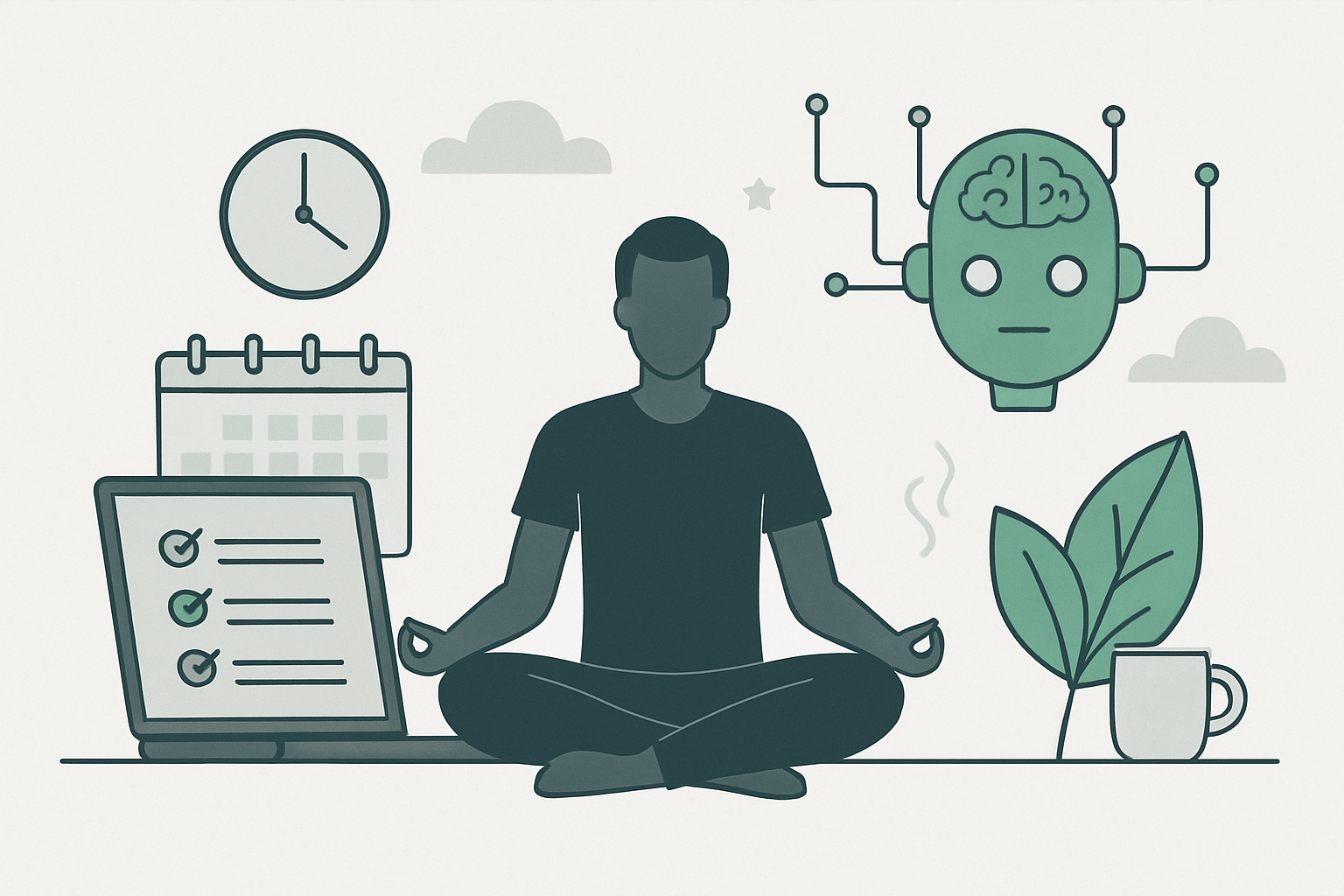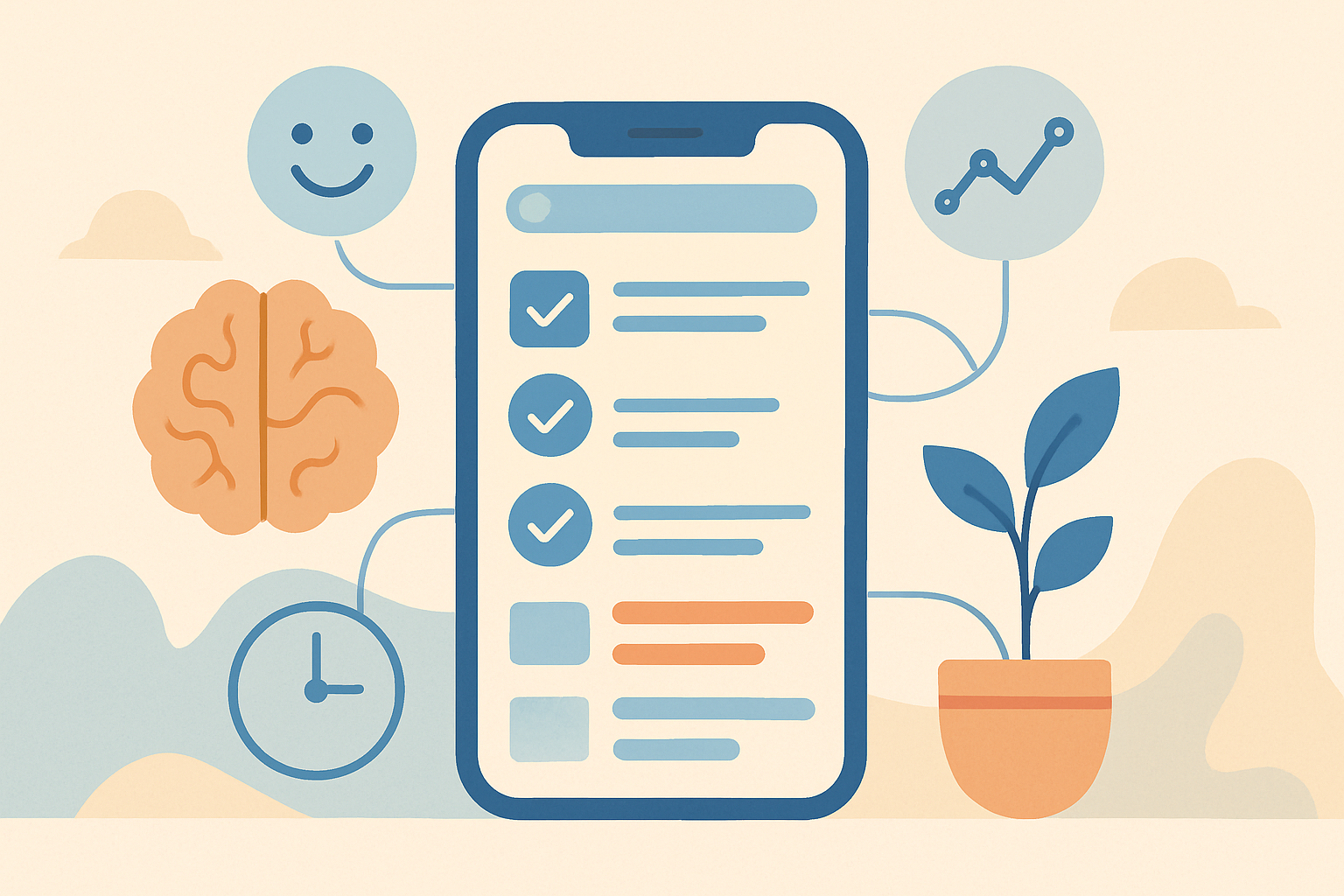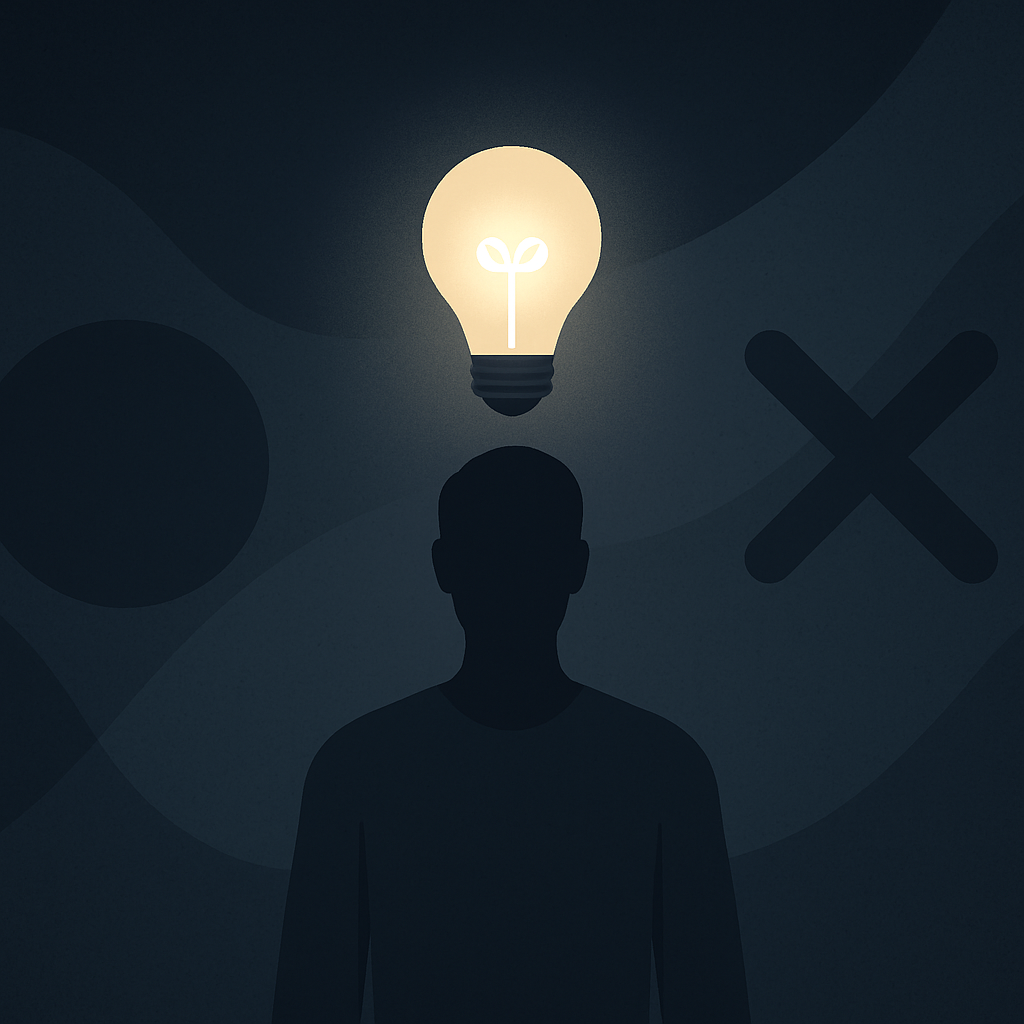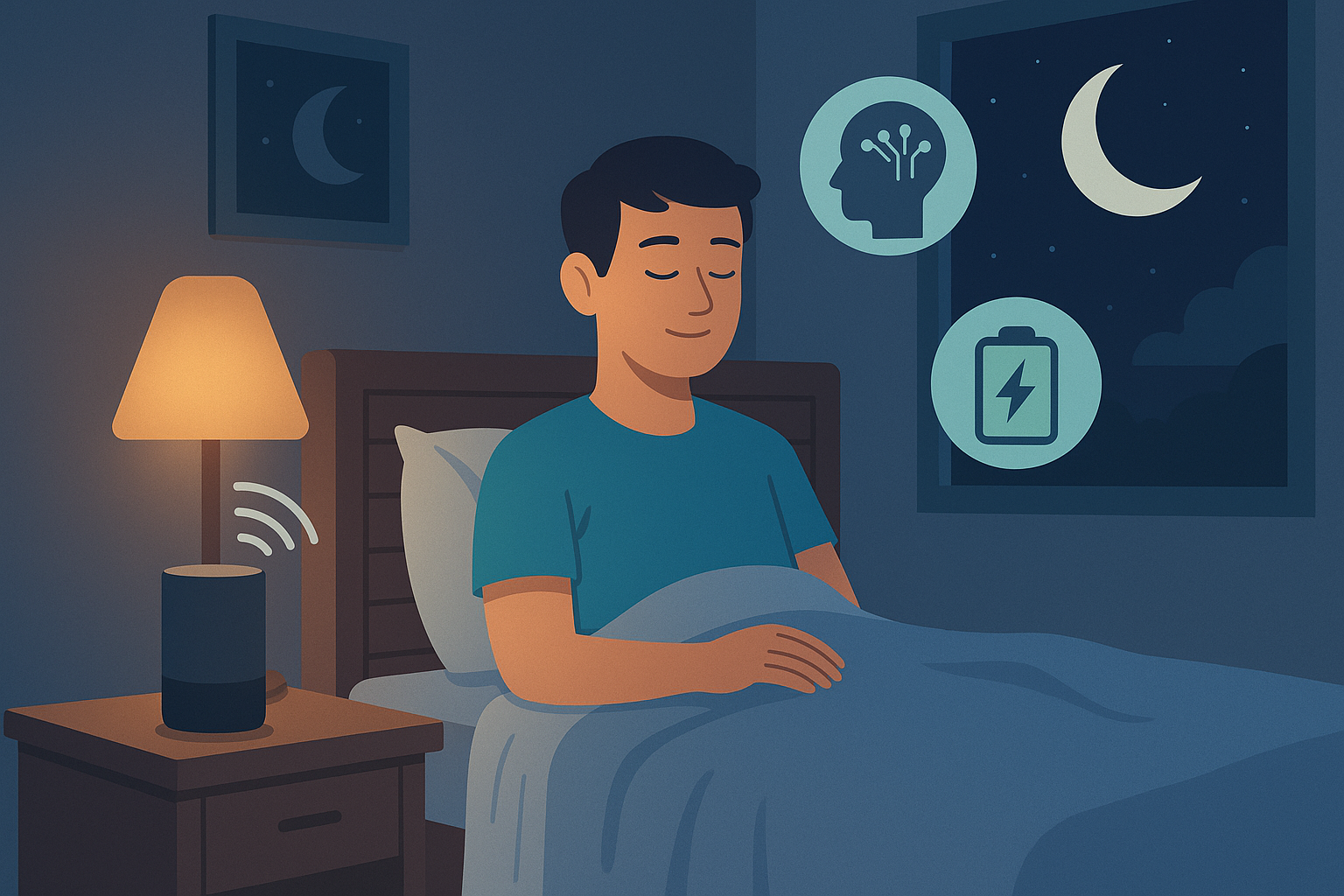AI Work-Life Balance. Every day feels like a race against the clock. Deadlines, meetings, and constant messages fill our calendars, leaving little space for rest — or for life itself.
For years, productivity culture has told us that more hours mean more results. But in 2025, the equation has changed. Artificial intelligence isn’t just helping us work faster; it’s helping us work smarter — and live better.
Welcome to the AI work-life balance era, where two hours of intentional recovery can transform the other ten hours of your day. This is not a wellness trend; it’s an operational system for your mind, powered by intelligent automation.

Why Work-Life Balance Needs Reinvention
The traditional idea of balance — eight hours of work, eight of rest, eight of life — no longer fits modern reality. The boundary between work and personal time has vanished. Notifications blur weekends, and “off” no longer exists.
AI offers a way out by redesigning the rhythm of our days instead of trying to separate them. It doesn’t demand you escape from work — it simply redistributes energy intelligently.
By analyzing your behavior, attention levels, and physiological data, AI learns when your brain hits overload. Then, it introduces micro-recoveries — short, data-informed resets that prevent stress from becoming burnout.
This is AI work-life balance in action: precision recovery, not passive rest.
The 2-Hour Reset Principle AI Work-Life Balance
The “2-Hour Reset” is not about adding more breaks. It’s about strategic decompression using insights that only AI can reveal.
AI systems like Reclaim AI, Headspace AI Coach, and Motion can monitor your calendar and identify where energy collapses throughout the day. They suggest two-hour recovery windows spread across your week — either as two short sessions or a single deep recovery block.
This structure trains your body and brain to recharge faster. Instead of waiting for weekends or vacations to recover, you reset daily, rhythmically, intelligently.
Think of it as calibration, not retreat.
Example: Your AI Work-Life Balance Schedule
Below is an example of how AI could structure your weekly rhythm to sustain focus and prevent fatigue.
| Time | Focus Mode | AI Function | Recovery Type | Expected Outcome |
|---|---|---|---|---|
| 8:00–10:00 | Deep Work | Motion AI | — | Peak output window |
| 10:00–10:15 | Micro Reset | Calm AI | Breath-guided break | Restores focus |
| 13:00–13:45 | Active Rest | Reclaim AI | Walk or stretch | Recharges body |
| 15:30–16:00 | AI Mind Reset | Mindsera | Reflection session | Mental clarity |
| 18:00–20:00 | 2-Hour Reset | AI Planner | Full disconnect | Energy recovery |
The key is that every break and block is dynamic. AI adjusts duration and timing based on how you actually feel — measured by patterns like keyboard rhythm, voice tone, and even posture from sensors.
This is personalized recovery, not general advice.
The Hidden Economics of Recovery AI Work-Life Balance
Most professionals underestimate how costly mental fatigue is. Losing focus for just 90 minutes can reduce creative efficiency by up to 40%.
AI work-life balance optimizes not only time but ROI on attention. By protecting energy proactively, AI ensures that every focused hour generates higher output — turning rest into a measurable productivity investment.
It’s not about working less; it’s about eliminating waste in your attention economy.
Tools That Enable AI Work-Life Balance
The technology for this reset already exists — you just need to connect the right ecosystem.
- Reclaim AI integrates with Google Calendar to automatically schedule personal and focus time.
- Calm AI Coach provides guided mindfulness based on biometric cues, adjusting the tone and speed of each session.
- Motion reorganizes daily schedules in real time to prevent task overload.
- Mindsera uses natural language processing to detect emotional fatigue in your journal entries.
Each tool contributes a piece of the puzzle. Together, they build a system where your workload and wellness coexist naturally.
Here’s how they interconnect:
| Goal | Tool | Function |
|---|---|---|
| Avoid overload | Reclaim AI | Automatically schedules downtime |
| Improve recovery | Calm AI Coach | Personalized breathing and reflection |
| Keep structure | Motion | AI-driven time reallocation |
| Track emotional tone | Mindsera | Detects stress signals in journaling |
With just these four tools, you can build your own intelligent reset routine — no more burnout cycles, no more guilt for pausing.
The Psychology of AI-Assisted Rest
AI work-life balance isn’t about escaping effort; it’s about restoring agency.
When rest is automated, guilt disappears. You don’t need to justify downtime — it’s programmed into your productivity model.
Neuroscientists at Stanford have shown that the prefrontal cortex (responsible for decision-making and creativity) recovers best through structured, short intervals of rest rather than long, irregular ones.
AI systems replicate that rhythm perfectly. They schedule micro-breaks exactly when your cognitive performance starts to drop, before you even realize it.
In essence, AI doesn’t just save time — it protects your mind.
The Two Types of Resets
The 2-Hour Reset operates on two levels: mental and physiological.
Mental resets involve detaching from task-oriented thought. AI-guided reflection sessions help your brain shift gears, reducing emotional residue from deep work.
Physiological resets target your nervous system — through guided breathing, postural change, or movement tracking. AI wearables like Whoop, Oura Ring, or Fitbit Sense detect when your stress response peaks and prompt specific recovery protocols.
A simple example:
Your Oura Ring notices heart rate variability dropping mid-afternoon. It alerts Calm AI, which triggers a 3-minute focused breathing sequence. Motion then delays your next meeting by 10 minutes.
That chain reaction is balance — automated, invisible, effective.
Practical Framework: The “AI Balance Loop”
You can implement AI work-life balance today using this framework.
| Phase | Duration | AI Function | Core Objective |
|---|---|---|---|
| Detect | Continuous | Sensors, journaling, or keyboard data | Identify early fatigue |
| Adjust | In real time | Calendar + Motion | Reallocate work blocks |
| Reset | 2 hours total | Guided reflection + rest | Restore focus and calm |
| Reflect | End of day | Mindsera | Learn from daily rhythm |
Each loop improves the next. AI learns how your body responds to stress and recovery, creating increasingly precise resets.
After a few weeks, you’ll notice your day stabilizes — fewer energy dips, faster cognitive recovery, and better separation between “work” and “life,” even if both happen in the same space.
Beyond Wellness: The Strategic Advantage
Companies are already adopting AI work-life balance systems to retain talent and reduce burnout-related turnover.
Research by Microsoft and Deloitte found that employees using AI-driven scheduling tools reported 29% higher focus and 34% lower stress after six weeks.
In leadership terms, this isn’t self-care — it’s operational optimization.
When your brain is balanced, creativity compounds. When your team recovers faster, innovation flows.
AI transforms well-being into strategy.
Real-World Example: The Designer Reset
Consider Sarah, a product designer leading two major projects. Her AI calendar detects that she consistently hits cognitive fatigue around 3 p.m. Motion reconfigures her schedule: instead of another meeting, it blocks 30 minutes for “reset mode.”
During that time, Calm AI launches a guided breathing session synced with ambient music and lighting. Ten minutes later, her heart rate stabilizes. She journals briefly in Mindsera, which notes emotional calm returning and highlights one insight: creative frustration decreases after micro-rest.
Over weeks, AI tracks these patterns, consolidating a daily “reset window.” Her output increases by 18%, and she starts finishing work earlier — without pushing harder.
That’s what intelligent balance looks like.
The Philosophy Behind AI Work-Life Balance
AI is not here to dominate human time — it’s here to return it.
The goal isn’t more control, but more freedom. By offloading the mechanics of scheduling, self-regulation, and energy tracking to intelligent systems, you reclaim bandwidth for what actually matters: relationships, creativity, and presence.
The future of productivity is not about optimization alone; it’s about alignment — a life where efficiency and peace can coexist.
Conclusion
The 2-Hour Reset is more than a productivity hack. It’s a new philosophy of time — one where work serves life, not the other way around.
Artificial intelligence gives us the tools to protect energy, design recovery, and restore rhythm. What used to require intuition and discipline now happens naturally through smart automation.
Work-life balance isn’t an abstract dream anymore.
It’s a measurable system — adaptive, intelligent, and deeply human.
When you let AI manage the flow of your day, you stop running from exhaustion and start living with intention.
Because the best productivity tool isn’t the one that helps you do more.
It’s the one that helps you be more.
By MBFProductivity
Further Reading & Related Insights
Internal link:
→ Smart Time Blocking: Let AI Plan Your Day — Learn how AI structures your schedule to create balance and prevent burnout.
External links:
→ Reclaim AI — Automate your personal time and recovery cycles with intelligent scheduling.
→ Headspace AI Coach — Adaptive mindfulness platform powered by AI to support mental reset and emotional clarity.
Blog
This section provides an overview of the blog, showcasing a variety of articles, insights, and resources to inform and inspire readers.
-

AI Habit Tracking and the New Rhythm of Modern Self-Improvement
AI Habit Tracking. Progress used to depend on discipline. Now, it depends on data.…
-

AI Decision Making and the New Discipline of Intentional Living
AI Decision Making. Every “yes” has a cost. Every time you agree to something…
-

The Perfect AI Night Routine to Sleep Better and Think Smarter
AI Night Routine. Your morning doesn’t begin when you wake up — it begins…
